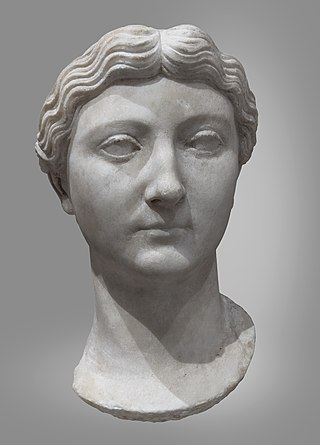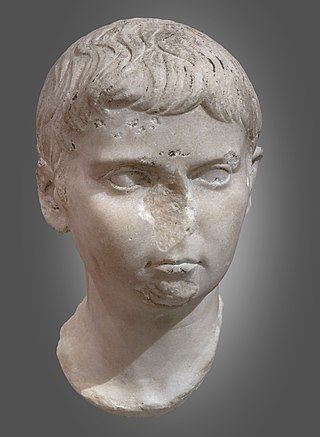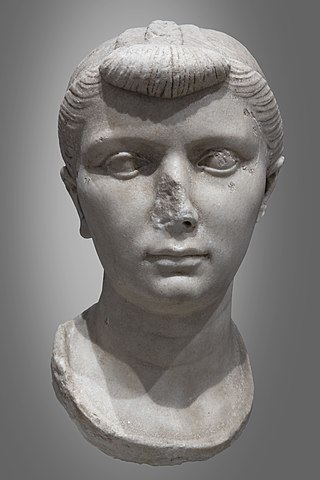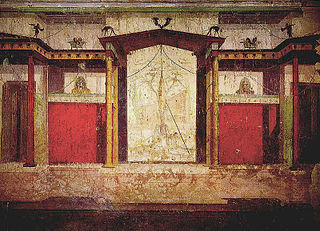
Tiberius Caesar Augustus was the second Roman emperor. He reigned from AD 14 until 37, succeeding his stepfather, the first Roman emperor Augustus. Tiberius was born in Rome in 42 BC. His father was the politician Tiberius Claudius Nero and his mother was Livia Drusilla, who would eventually divorce his father, and marry the future-emperor Augustus in 38 BC. Following the untimely deaths of Augustus' two grandsons and adopted heirs, Gaius and Lucius Caesar, Tiberius was designated Augustus' successor. Prior to this, Tiberius had proved himself an able diplomat, and one of the most successful Roman generals: his conquests of Pannonia, Dalmatia, Raetia, and (temporarily) parts of Germania laid the foundations for the empire's northern frontier.

Livia Drusilla was Roman empress from 27 BC to AD 14 as the wife of emperor Augustus. She was known as Julia Augusta after her formal adoption into the Julian family in AD 14.

Marcus Agrippa Postumus, later named Agrippa Julius Caesar, was a Roman nobleman who was the youngest son of Marcus Vipsanius Agrippa and Julia the Elder, the daughter and only biological child of Roman Emperor Augustus, who initially considered Postumus as a potential successor and formally adopted him as his heir. However, Augustus banished him from Rome in AD 6 on account of his ferocia. In effect though not in law, the action cancelled his adoption and virtually assured Tiberius' emplacement as Augustus' sole heir. Postumus was ultimately executed by his own guards shortly after Augustus' death in AD 14.

Gaius Caesar was the grandson and heir to the throne of Roman emperor Augustus, alongside his younger brother Lucius Caesar. Although he was born to Marcus Vipsanius Agrippa and Julia, Augustus' only daughter, Gaius and his younger brother, Lucius Caesar, were raised by their grandfather as his adopted sons and joint-heirs to the empire. He would experience an accelerated political career befitting a member of the Julio-Claudian dynasty, with the Roman Senate allowing him to advance his career without first holding a quaestorship or praetorship, offices that ordinary senators were required to hold as part of the cursus honorum.

In ancient Roman religion, Concordia is the goddess who embodies agreement in marriage and society. Her Greek equivalent is usually regarded as Harmonia, with musical harmony a metaphor for an ideal of social concord or entente in the political discourse of the Republican era. She was thus often associated with Pax ("Peace") in representing a stable society. As such, she is more closely related to the Greek concept of homonoia, which was also represented by a goddess.

Julia the Elder, known to her contemporaries as Julia Caesaris filia or Julia Augusti filia, was the daughter and only biological child of Augustus, the first Roman Emperor, and his second wife, Scribonia. Julia was also stepsister and second wife of the Emperor Tiberius; maternal grandmother of the Emperor Caligula and the Empress Agrippina the Younger; grandmother-in-law of the Emperor Claudius; and maternal great-grandmother of the Emperor Nero. Her epithet "the Elder" distinguishes her from her daughter, Julia the Younger.

Marcus Claudius Marcellus was the eldest son of Gaius Claudius Marcellus and Octavia Minor, sister of Augustus. He was Augustus' nephew and closest male relative, and began to enjoy an accelerated political career as a result. He was educated with his cousin Tiberius and traveled with him to Hispania where they served under Augustus in the Cantabrian Wars. In 25 BC he returned to Rome where he married his cousin Julia, who was the emperor's daughter. Marcellus and Augustus' general Marcus Vipsanius Agrippa were the two popular choices as heir to the empire. According to Suetonius, this put Agrippa at odds with Marcellus, and is the reason why Agrippa traveled away from Rome to Mytilene in 23 BC.

The Porticus Octaviae is an ancient structure in Rome. The colonnaded walks of the portico enclosed the Temples of Juno Regina (north) and Jupiter Stator (south), as well as a library. The structure was used as a fish market from the medieval period up to the end of the 19th century.

Posillipo is an affluent residential quarter of Naples, southern Italy, located along the northern coast of the Gulf of Naples.

The Porticus Octavia, also known as the Portico of Octavius, was a portico in ancient Rome built by Gnaeus Octavius in 168 BC to commemorate his capture of Perseus of Macedonia during the Third Macedonian War. It stood between the Theatre of Pompey and the Circus Flaminius beside the Porticus Metelli. Pliny describes it as a double portico with bronze Corinthian capitals, for which it was also called the Corinthian Portico. It may have been the earliest use of this architectural order in Rome and is possibly to be identified with remains on the Via S. Nicola ai Cesarini, represented in the Severan Marble Plan. Velleius Paterculus called it "by far the loveliest" of the porticoes of his time.

The Temple of Concord in the ancient city of Rome refers to a series of shrines or temples dedicated to the Roman goddess Concordia, and erected at the western end of the Roman Forum. The earliest temple is believed to have been vowed by Marcus Furius Camillus in 367 BC, but it may not have been built until 218 BC by L. Manlius. The temple was rebuilt in 121 BC, and again by the future emperor Tiberius between 7 BC and AD 10.

Macellum Liviae was a shopping complex built by Augustus in the name of his wife Livia built on the Esquiline Hill in Rome.

The Temple of Divus Augustus was a major temple originally built to commemorate the deified first Roman emperor, Augustus. It was built between the Palatine and Capitoline Hills, behind the Basilica Julia, on the site of the house that Augustus had inhabited before he entered public life in the mid-1st century BC. It is known from Roman coinage that the temple was originally built to an Ionic hexastyle design. However, its size, physical proportions and exact site are unknown. Provincial temples of Augustus, such as the much smaller Temple of Augustus in Pula, now in Croatia, had already been constructed during his lifetime. Probably because of popular resistance to the notion, he was not officially deified in Rome until after his death, when a temple at Nola in Campania, where he died, seems to have been begun. Subsequently, temples were dedicated to him all over the Roman Empire.

Publius Vedius Pollio was a Roman of equestrian rank, and a friend of the Roman emperor Augustus, who appointed him to a position of authority in the province of Asia. In later life, he became infamous for his luxurious tastes and cruelty to his slaves – when they displeased him, he had them fed to "lampreys" that he maintained for that purpose, which was deemed to be an exceedingly cruel act. When Vedius tried to apply this method of execution to a slave who broke a crystal cup, Emperor Augustus was so appalled that he not only intervened to prevent the execution but had all of Pollio's valuable drinking vessels deliberately broken. This incident, and Augustus's demolition of Vedius's mansion in Rome, which Augustus inherited in Vedius's will, were frequently referred to in antiquity in discussions of ethics and of the public role of Augustus.

The House of Augustus, or the Domus Augusti, is situated on the Palatine Hill in Rome, Italy. This house has been identified as the primary place of residence for the emperor Augustus.
The Porticus Vipsania, also known as the Portico of Agrippa, was a portico near the Via Flaminia in the Campus Agrippae of ancient Rome, famed for its its map of the world. It was designed by Marcus Vipsanius Agrippa and constructed by his sister Vipsania Polla after Agrippa died. The map was named either directly after Vipsania Polla or the gens Vipsania, which Polla and her brother Agrippa belonged to.

The Regio III Isis et Serapis was the third regio of imperial Rome, under Augustus's administrative reform. Regio III took its name from the double sanctuary of Isis and Serapis, in the area of the Via Praenestina, containing the valley that was to be the future site of the Colosseum, and parts of the Oppian and Esquiline hills.

The Regio IV Templum Pacis is the fourth regio of imperial Rome, under Augustus's administrative reform. Regio IV took its name from the Temple of Peace built in the region by the emperor Vespasian. It includes the valley between the Esquiline and the Viminal hills, the popular area of the Suburra, and the Velian Hill.

The Regio V Esquiliae is the fifth regio of imperial Rome, under Augustus's administrative reform. Regio V took its name from the Esquiline Hill. It contains parts of the Oppian Hill and Cispian Hill and of the Esquiline, plus the plain just outside the Servian Wall.




















